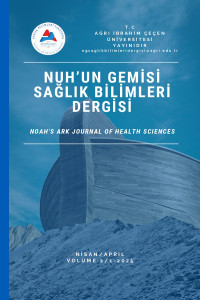Abstract
Sarkopeni, yaşlanma ile görülen ve iskelet kası kütlesi ile fonksiyonunda azalma ile karakterize edilen önemli bir sağlık problemidir. Son yıllarda yapılan çalışmalar, sarkopeni ile nörodejeneratif hastalıklar Parkinson, Alzheimer ve ALS arasında güçlü bir ilişki olduğunu ortaya koymaktadır. Nörodejeneratif hastalıklar, sinir sistemi hücrelerinin kaybı ve yapısal bozulmalarla seyreden hastalıklardır ve bu süreç, kas kütlesi ve fonksiyon kaybını hızlandırmaktadır. Bu hastalıklarda motor nöron kaybı, inflamasyon, oksidatif stres, mitokondriyal disfonksiyon ve sinir-kas ileti bozuklukları hem sarkopeninin gelişimine neden olmakta hem de hastalık seyrini ağırlaştırmaktadır. Sarkopeninin önlenmesi ve nörodejenerasyonun ilerlemesinin yavaşlatılmasında fizyoterapi ve rehabilitasyon uygulamaları büyük önem taşımaktadır. Bu derlemede, sarkopeni ile nörodejeneratif hastalıklar arasındaki ilişki ve bu hastalıklarda kullanılan fizyoterapi ve rehabilitasyon yaklaşımları güncel literatür doğrultusunda ele alınmıştır. Bu çalışmada literatür derlemesi amacıyla, Google Scholar ve PubMed veri tabanları kullanılmıştır.
Keywords
Ethical Statement
Bu çalışma literatür taraması ve derleme türünde olduğundan herhangi bir etik kurul onayı gerektirmemektedir.
Supporting Institution
herhangi bir kurum veya kuruluş yoktur
References
- Abbruzzese, G., Marchese, R., Avanzino, L., & Pelosin, E. (2016). Rehabilitation for Parkinson's disease: Current outlook and future challenges. Parkinsonism & Related Disorders, 22, S60–S64.
- Aslam, M. A., Ma, E. B., & Huh, J. Y. (2023). Pathophysiology of sarcopenia: Genetic factors and their interplay with environmental factors. Metabolism, 149, 155711.
- Azzolino, D., Piras, R., Zulueta, A., Lucchi, T., & Lunetta, C. (2024). Amyotrophic lateral sclerosis as a disease model of sarcopenia. Age and Ageing, 53(9), afae209.
- Cruz-Jentoft, A. J., Baeyens, J. P., Bauer, J. M., Boirie, Y., Cederholm, T., Landi, F., Martin, F. C., Michel, J.-P., Rolland, Y., & Schneider, S. M. (2010). Sarcopenia: European consensus on definition and diagnosis: Report of the European Working Group on Sarcopenia in Older People. Age and Ageing, 39(4), 412–423.
- Cruz-Jentoft, A. J., & Sayer, A. A. (2019). Sarcopenia. The Lancet, 393(10191), 2636–2646.
- Cruz-Jentoft, A. J., Romero-Yuste, S., Chamizo Carmona, E., & Nolla, J. M. (2021). Sarcopenia, immune-mediated rheumatic diseases, and nutritional interventions. Aging Clinical and Experimental Research, 1–11.
- Damluji, A. A., Alfaraidhy, M., AlHajri, N., Rohant, N. N., Kumar, M., Al Malouf, C., Bahrainy, S., Ji Kwak, M., Batchelor, W. B., & Forman, D. E. (2023). Sarcopenia and cardiovascular diseases. Circulation, 147(20), 1534–1553.
Abstract
Sarcopenia is an important health problem associated with aging and characterised by a decrease in skeletal muscle mass and function. Recent studies have revealed a strong association between sarcopenia and neurodegenerative diseases Parkinson's, Alzheimer's and ALS. Neurodegenerative diseases are characterised by loss of nervous system cells and structural deterioration, which accelerates the loss of muscle mass and function. In these diseases, motor neuron loss, inflammation, oxidative stress, mitochondrial dysfunction and neuromuscular conduction disorders both cause the development of sarcopenia and aggravate the disease course. Physiotherapy and rehabilitation applications are of great importance in preventing sarcopenia and slowing the progression of neurodegeneration. In this review, the relationship between sarcopenia and neurodegenerative diseases and physiotherapy and rehabilitation approaches used in these diseases are discussed in line with the current literature. In this study, Google Scholar and PubMed databases were used for literature review
Keywords
References
- Abbruzzese, G., Marchese, R., Avanzino, L., & Pelosin, E. (2016). Rehabilitation for Parkinson's disease: Current outlook and future challenges. Parkinsonism & Related Disorders, 22, S60–S64.
- Aslam, M. A., Ma, E. B., & Huh, J. Y. (2023). Pathophysiology of sarcopenia: Genetic factors and their interplay with environmental factors. Metabolism, 149, 155711.
- Azzolino, D., Piras, R., Zulueta, A., Lucchi, T., & Lunetta, C. (2024). Amyotrophic lateral sclerosis as a disease model of sarcopenia. Age and Ageing, 53(9), afae209.
- Cruz-Jentoft, A. J., Baeyens, J. P., Bauer, J. M., Boirie, Y., Cederholm, T., Landi, F., Martin, F. C., Michel, J.-P., Rolland, Y., & Schneider, S. M. (2010). Sarcopenia: European consensus on definition and diagnosis: Report of the European Working Group on Sarcopenia in Older People. Age and Ageing, 39(4), 412–423.
- Cruz-Jentoft, A. J., & Sayer, A. A. (2019). Sarcopenia. The Lancet, 393(10191), 2636–2646.
- Cruz-Jentoft, A. J., Romero-Yuste, S., Chamizo Carmona, E., & Nolla, J. M. (2021). Sarcopenia, immune-mediated rheumatic diseases, and nutritional interventions. Aging Clinical and Experimental Research, 1–11.
- Damluji, A. A., Alfaraidhy, M., AlHajri, N., Rohant, N. N., Kumar, M., Al Malouf, C., Bahrainy, S., Ji Kwak, M., Batchelor, W. B., & Forman, D. E. (2023). Sarcopenia and cardiovascular diseases. Circulation, 147(20), 1534–1553.
Details
| Primary Language | Turkish |
|---|---|
| Subjects | Physical Activity and Health, Aged Care Nursing, Physiotherapy |
| Journal Section | Reviews |
| Authors | |
| Publication Date | April 30, 2025 |
| Submission Date | April 15, 2025 |
| Acceptance Date | April 29, 2025 |
| Published in Issue | Year 2025 Volume: 2 Issue: 1 |


